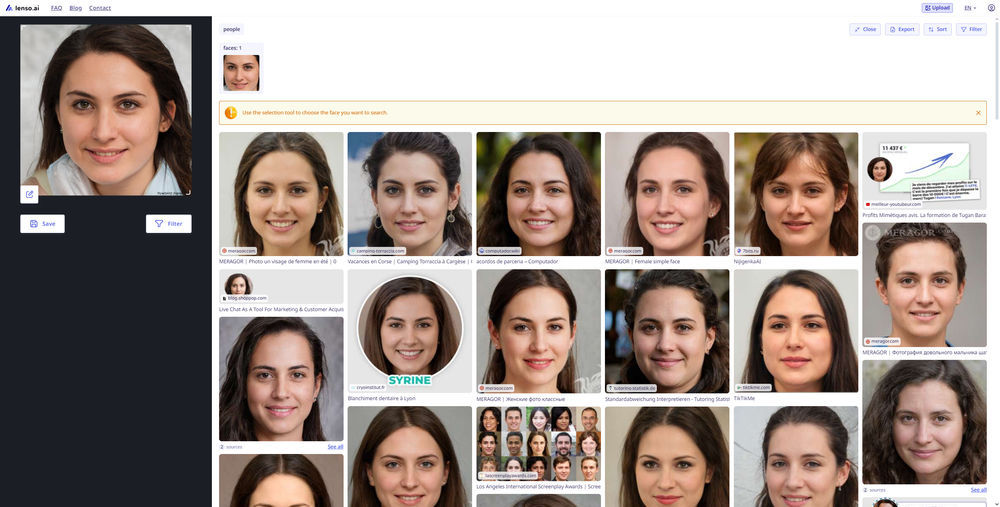
Preview in:
Scammers’ New Tactics
As AI and machine learning have advanced, scammers have developed new methods of deception. Today, it's easier than ever to edit photos or videos or even generate entirely fake faces with minimal skill.
Victims of online scams have reported the following tactics used by catfishers:
- Face Filters in Video Calls: The use of face filters has become widespread. These filters are often built into the apps we use daily and can be difficult to detect.
- AI-Generated Faces: AI-generated faces have become so common that it's increasingly difficult to tell if a face is real or not.
- AI-Generated Voices: AI voice technology has made it easy for scammers to send voice messages that conceal their accents or make them sound like they're from another country. To recognize AI-generated voices, you can listen to popular examples on platforms like ElevenLabs.
Past Challenges in Detecting Online Scams
In the past, identifying a scam was much harder. There were no dedicated tools for detecting fraud, and AI technology was rapidly evolving. However, today, things are improving as new solutions emerge to help expose scammers.
Using Facial Recognition to Combat Dating Scams
Breakthrough Research
Recent studies, such as this one, suggest that AI-generated images can sometimes be identified by analyzing light reflections in the eyes. Additionally, news outlets like The Guardian have published tutorials on how to spot deepfakes. These resources are valuable tools for protecting your privacy online.
Free Facial Recognition Tools
Not All AI is Dangerous
While AI is often associated with scams, it’s also a tool we can use to detect fraud. Many scam-detection websites leverage the same AI technology used by scammers.
This article offers an in-depth explanation of how AI works in image searches and detection, showing that it's not magic but sophisticated software.
Face Recognition Tools Online
Many scammers use AI-generated or stolen photos. To verify if you’re dealing with a fake, try lenso.ai’s face search*.
*Available in select regions

How to Use It:
- Go to lenso.ai.
- Upload the images you received. Don’t worry—lenso does not store them permanently.
- View the results in the People category and look for suspicious details.
What to Look For:
- No results for the same face, but different faces in the People category—this could mean the image was AI-generated.

- No results at all—while most people have some online presence, not finding photos isn’t necessarily a red flag. Look for other warning signs.
- Results with the same face but different names or locations—this could indicate that the image was stolen, or the person has lied about their identity.
How to Confirm It’s the Same Person:
If you find several matching images, try to locate older ones to ensure authenticity. Sometimes scammers upload fake information across different platforms. With lenso, you can sort by “Oldest to Newest” to find the earliest matches.
Spotting scams can be challenging, but as AI advances, so do the tools to expose scammers. Visit lenso.ai to conduct a reverse image search today.
Continue reading

News
AI Reverse Image Search as a Competitive Intelligence Tool for Ecommerce Brands
Scroll through any ecommerce site today and you’ll see polished product photos everywhere. Those images carry far more information than most brands realize. With AI reverse image search, they turn into a practical source of competitive intelligence.

News
Lenso.ai API | Facial Search and Reverse Image Search API
If you are looking for a face search API or a reverse image search API for your page, tool, or software, lenso.ai’s API is a product for you! Read this article to find out what features lenso.ai’s API offers, and how you can use it in your own application. There were also some changes made for current clients - don’t miss them!

News
Best PimEyes Alternatives & Competitors for reverse face search in 2025
Looking for an accurate facial recognition tool that's not the popular one? Discover and try best PimEyes alternatives and competitors in 2025.

News
Is there a better tool than PimEyes for face search?
You’re probably familiar with PimEyes as one of the most well-known face search tools. Maybe you’ve tried it yourself or just read about it. But is there a better tool than PimEyes to help you find your photos online? Let’s find out.

News
Top 5 Ways to Find Your Leaked Photos Online
If you think the images you uploaded have been shared without your knowledge, or if you suspect someone shared your photos online without your consent, keep reading. In this article, we will show you 5 ways to find your leaked photos online and take them down, as well as how to avoid future leaks.
